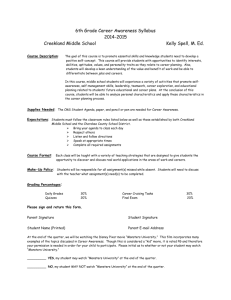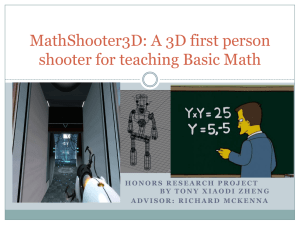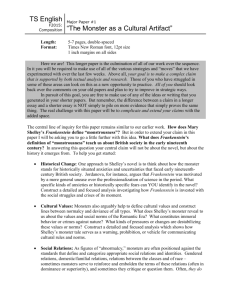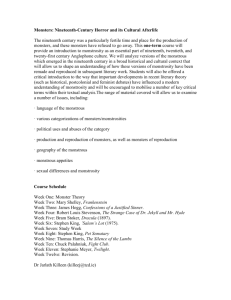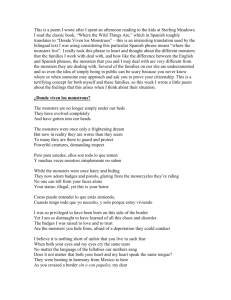REL/JSP 200: Gods and Monsters Syracuse University Fall 2015
advertisement
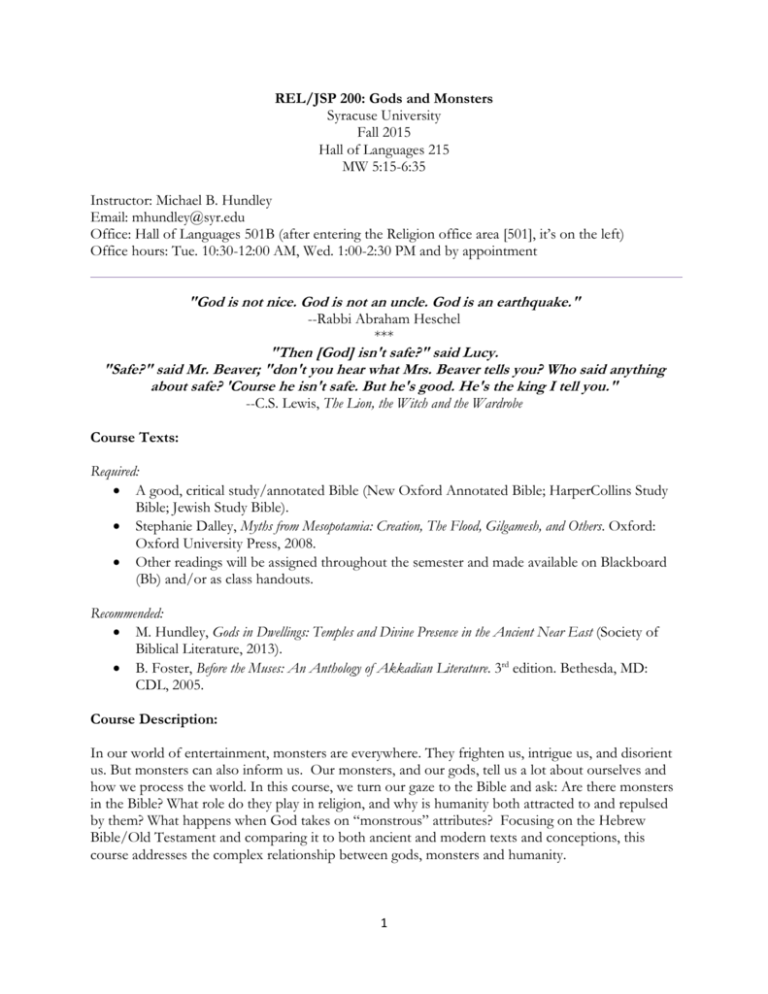
REL/JSP 200: Gods and Monsters Syracuse University Fall 2015 Hall of Languages 215 MW 5:15-6:35 Instructor: Michael B. Hundley Email: mhundley@syr.edu Office: Hall of Languages 501B (after entering the Religion office area [501], it’s on the left) Office hours: Tue. 10:30-12:00 AM, Wed. 1:00-2:30 PM and by appointment "God is not nice. God is not an uncle. God is an earthquake." --Rabbi Abraham Heschel *** "Then [God] isn't safe?" said Lucy. "Safe?" said Mr. Beaver; "don't you hear what Mrs. Beaver tells you? Who said anything about safe? 'Course he isn't safe. But he's good. He's the king I tell you." --C.S. Lewis, The Lion, the Witch and the Wardrobe Course Texts: Required: A good, critical study/annotated Bible (New Oxford Annotated Bible; HarperCollins Study Bible; Jewish Study Bible). Stephanie Dalley, Myths from Mesopotamia: Creation, The Flood, Gilgamesh, and Others. Oxford: Oxford University Press, 2008. Other readings will be assigned throughout the semester and made available on Blackboard (Bb) and/or as class handouts. Recommended: M. Hundley, Gods in Dwellings: Temples and Divine Presence in the Ancient Near East (Society of Biblical Literature, 2013). B. Foster, Before the Muses: An Anthology of Akkadian Literature. 3rd edition. Bethesda, MD: CDL, 2005. Course Description: In our world of entertainment, monsters are everywhere. They frighten us, intrigue us, and disorient us. But monsters can also inform us. Our monsters, and our gods, tell us a lot about ourselves and how we process the world. In this course, we turn our gaze to the Bible and ask: Are there monsters in the Bible? What role do they play in religion, and why is humanity both attracted to and repulsed by them? What happens when God takes on “monstrous” attributes? Focusing on the Hebrew Bible/Old Testament and comparing it to both ancient and modern texts and conceptions, this course addresses the complex relationship between gods, monsters and humanity. 1 Learning Outcomes: After completing this course, students will be able to: 1) Critically analyze orally and in writing select texts related to the monstrous and the divine 2) Articulate historically and conceptually the biblical portrait of God and monsters 3) Compare the ideas expressed in the Bible with select analogs 4) Articulate the implications the biblical portrait has on the issues of divine power, goodness and justice 5) Discuss how the biblical presentation aligns with modern conceptions of God 6) Articulate the importance of context for interpretation, both the original context and the interpreter’s context Assessment: The degree to which students achieve these objectives will be evaluated in a variety of ways. First, all of the objectives will be assessed throughout the semester based on students’ performance in class, which will include the answers they give to direct questions, the comments and questions that they offer, and the contributions they make to small-group and whole-class discussions. Second, the onepage papers will demonstrate and serve as criteria for assessing students’ attainment of learning outcomes. Third, the student presentation, the god project and monster project will demonstrate the students’ grasp of the material and their achievement of the objectives. Fourth, all questions on the final examination will also be an important indication of meeting the objectives. Course Requirements: Attendance, preparation, and participation (15% of the grade): Your engagement in class will affect not only your grade, but also the success of the course. If you are present, prepared and engaged, class will be interesting, provocative, and worthwhile, and you will do well. I truly want to hear what you have to say and will treat you and your opinions with respect. In order to participate, you have to be in class. Attendance will be taken at every meeting. Two unexcused absences are permissible; more than two will lower your grade unless you bring a compelling note from a dean, doctor, coach or employer. In order to meaningfully participate, you have to prepare. Rather than just skimming through the reading, I expect you to spend time with it; underline, take notes, analyze, ponder larger implications, and prepare to communicate what you have learned in class. As you read, keep in mind three basic questions: 1) What does the text say? 2) How does it say it? 3) Why does it say this and not something else? In class, I expect you to participate regularly, by offering opinions and asking questions. Throughout the course of the semester, you will also be expected to post regularly on Blackboard, asking questions, making comments, and simply noting what you find interesting, helpful, and/or troubling. As a general rule of thumb, you should try to post at least once a week, with a minimum of 10 2 posts over the course of the semester. Please post by 9:00 AM the morning of class so that I have time to review it and the opportunity to bring it up in class. I am not looking for spiritual or church answers, or even the “right” answers. As with all literature and more so than most, the Bible allows for and even invites multiple interpretations. I expect you to think for yourselves, to analyze the text critically, and to make carefully reasoned arguments backed by evidence. You may take any position, no matter how blasphemous, provided it is empirically grounded and well-articulated. Presentation (5%) Each student will randomly select a monster or god at the beginning of class. S/he will be responsible for a 5-10 minute presentation on that figure at the beginning of the appropriate class, which will involve a summary of the character and their place in the story. Each presentation will also provide a modern counterpoint (a related modern example), and the student will need to explain why they made that link (more specific instructions will be given separately). Papers and Projects (55%) 1 creative god project (20%) 1 creative monster project (25%) 2 1-page critical response papers (single-spaced) (5% each) Specific instructions will accompany the assignment of the god project, monster project and 1-page papers. For the god and monster projects, you will be given a list of possible projects to choose from (if you prefer not to do a creative project, you can write a five-page paper as an alternative). Rather than simply regurgitate the ideas of others, I encourage you to think for yourselves, be creative, trust your instincts, and let the text and your intuition take you wherever they lead. NO LATE ASSIGNMENTS ACCEPTED. Final Exam (25%) The final exam will consist of two parts: short answers and essays. The test will be cumulative and cover both the readings and lectures. Before the test, you will be given a study guide with 8 sample essay questions, 5 of which will appear on the final exam. On the final, you will be asked to answer 3 of those 5 questions. Grading Scale: A = 95-100 A- = 90-94 B+= 87-89 B = 83-86 B- = 80-82 C+= 77-79 C = 73-76 C- = 70-72 D+ = 67-69 D = 63-66 D- = 60-62 F = <60 Academic Integrity: The Syracuse University Academic Integrity Policy holds students accountable for the integrity of the work they submit. Students should be familiar with the Policy and know that it is their 3 responsibility to learn about instructor and general academic expectations with regard to proper citation of sources in written work. The policy also governs the integrity of work submitted in exams and assignments as well as the veracity of signatures on attendance sheets and other verifications of participation in class activities. Serious sanctions can result from academic dishonesty of any sort. In this course, students found cheating on a test or assignment will receive zero (0) credit for that test or assignment. For more information and the complete policy, see http://academicintegrity.syr.edu. Religious Observances Policy: SU religious observances policy, found at http://supolicies.syr.edu/emp_ben/religious_observance.htm, recognizes the diversity of faiths represented among the campus community and protects the rights of students, faculty, and staff to observe religious holidays according to their tradition. Under the policy, students are provided an opportunity to make up any examination, study, or work requirements that may be missed due to are religious observance provided they notify their instructors before the end of the second week of classes. For fall and spring semesters, an online notification process is available through MySlice/StudentServices/Enrollment/MyReligiousObservances from the first day of class until the end of the second week of class. Disability-Related Accommodations: Students who are in need of disability-related academic accommodations must register with the Office of Disability Services (ODS), 804 University Avenue, Room 309, 315-443-4498. Students with authorized disability-related accommodations should provide a current Accommodation Authorization Letter from ODS to the instructor and review those accommodations with the instructor. Accommodations, such as exam administration, are not provided retroactively; therefore, planning for accommodations as early as possible is necessary. For further information, see the ODS website, Office of Disability Services http://disabilityservices.syr.edu/. Other Important Notes: Please do not use phones or other hand-held electronic devices during class. If you wish to use a notebook/laptop/tablet computer during class, you must request permission in writing from me and explain how such usage will enhance your learning. You will also be required to sit in the first two rows of the classroom when using a computer. Changes to the syllabus, important announcements and other information will be sent to students via e-mail or posted on Blackboard. Please check your Syracuse email and Blackboard regularly. The five best ways to ruin your class participation grade: Write, read, send, and/or receive text messages or other types of communications (e.g., e-mail, social networking, etc.) during class. Allow your mobile electronic device to ring, vibrate, or make other noises during class. Speak while another student is contributing a comment to class discussion. Leave the classroom on a regular basis while class is in session. Participate unenthusiastically in small-group discussions and activities. 4 Course Schedule: I) ORIENTATION Mon., Aug 31 Introduction, and Why This Class Isn’t Just About the Bible: The Context Read “Ancient Near East” on Wikipedia Wikipedia on “Ancient Greek Religion” (until Practices), “Greek Mythology” (until Greek and Roman conceptions of myth), “Hindu mythology” Wed., Sep 2 What is a God? Read Hundley, “Here a God, There a God,” 68-72, 80-83 (Bb) Sommer, The Bodies of God and the World of Ancient Israel, 1-4, 12-30 (Bb) Questions: What do you think of when you hear the word ‘god’? In the ancient Near East, what qualifies as a god? What unites all of these beings? What is the relationship between them? How is the ancient portrait of gods different than modern ones? Different than yours? Mon., Sep 7 No class. Labor Day. Wed., Sep 9 What is a Monster? Read ‘Monster’ on Wikipedia Beal, Religion and Its Monsters, 1-10 (Bb) Hundley, “Here a God,” 93-95 (Bb) Questions: How do they define monsters? How would you define it? What are the limitations of your definition? Why are monsters both fascinating and frightening? How are they related to demons? Can people be monsters? Mon., Sep 14 How to Tell the Difference Read Beal, Religion and its Monsters, 106-16 (Bb) Mesopotamian Lugal-e (Bb) Questions: How can you tell if a being is a god or monster? Are they mutually exclusive categories? Who is the monster in Lugal-e? How are the hero and villain described in similar terminology? How can you tell the difference? What does the monster look like? Wed., Sep 16 Geography and Access Read Smith, “The Structure of Divinity at Ugarit and Israel,” 38-57 (Bb) Hundley, “Divine Presence in the Ancient Near Eastern Temple” (Bb) Questions: Where are gods located? Monsters? What are they associated with? Do you want to access them? For what? How do you do it? Mon., Sep 21 Description versus Depiction Read Mesopotamian “Hymn to Ninurta” (Bb) Excerpt from Enuma Elish (Bb) Look at images of Ninurta and Marduk (Bb) 5 Questions: How are images of the gods different than their descriptions? Why? What is the situation with monsters? How and why are descriptions and depictions of monsters and gods similar and different? Wed., Sep 23 II) YHWH: Divine Description vs. Depiction Read Isaiah 49:25-26; 63:1-6; Ps 110:6; Revelation 14:14-20 Exodus 19-20; Deuteronomy 4-5 Exodus 24:9-10; 33-34 Exodus 24:15-18; 29:44-46; 40:34-38; Ezekiel 1 Deuteronomy 12; 2 Samuel 7; 1 Kings 8 Questions: How does the first set of texts depict God and why? Why does the Bible prohibit images of God? Can God be seen? What forms does he take? Why does the text use Glory and the Name to represent divine presence? First 1-page paper due! A GALLERY OF GODS AND MONSTERS Mon., Sep 28 Gods and Monsters: A Survey Read Tikvah Frymer-Kensky, “The Pantheon” (Bb) Hundley, Gods in Dwellings 153-7, 207-13, 285-93, 333-40 (Bb) Questions: What are the general conceptions of gods and monsters? How do they relate? How do people relate to them? How are the portraits in the different cultures similar and different? Wed., Sep 30 The Bible’s God with a Capital G Hundley, “Divine Fluidity?”, 24-5 (under subsection “Competition and Character-Poaching) (Bb) P. Miller, The Religion of Ancient Israel, 23-29 (Bb) Questions: Where did God come from? What is his relationship to the other ‘gods’? How does the Bible establish his supremacy? Mon., Oct 5 YHWH and the Israelite Divine World Read Genesis 1:26; 6:1-2 Psalm 82, 89 Job 1-2 Deuteronomy 32:8-9 1 Kings 22:19 Exodus 12:23; 2 Samuel 24:16 Genesis 3:24 Genesis 16 Isaiah 6:1-7 Questions: Who or what else is in the Israelite divine world? What do these texts tell us they are and are they like? Why don’t we call them gods? Wed., Oct 7 Monsters in the Bible: A First Look Read Job 40:15-41:31 Isaiah 51:9-10; Job 26:12; Psa 89:10-11 6 Genesis 1:21; Psalm 74:12-17; Isaiah 27:1 Numbers 21:4-9; 2 Kings 18:4-6; Genesis 3 Genesis 6:1-8 Ezekiel 1 Questions: What makes them monsters? Are they good or bad? Are they also gods? III) MONSTERS IN CREATION AND DESTRUCTION: HOW THE WORLD CAME TO BE THE WAY IT IS Mon., Oct 12 Monsters in Creation or Monsters who Create? Read the Mesopotamian Atrahasis (Dalley 1-38) Read Greek Hesiod’s Theogony Introduction and 35-43 (Bb) Questions: In Atrahasis, why do the gods create humanity? Why destroy? What are the issues and what is the resolution? Who are the monsters? Where did the gods come from in Hesiod’s Theogony? Who are the gods and who are the monsters? What distinguishes them? Wed., Oct 14 Goddesses and/as Monsters: Protective, Nurturing Mothers or Bloodthirsty Chaos Beasts? Read: The Egyptian Heavenly Cow (Bb) Anat (Bb) Questions: What role do Hathor and Anat play in these stories? Does that make them monsters in addition to being goddesses? Why are some goddesses presented as extreme characters, capable of nurturing love and wanton destruction? Mon., Oct 19 Why the World is the Way it is in the Bible: Creation, Eden and the Flood Read Genesis 1-3; 6-9 Questions: How do the biblical texts imagine creation and the flood? What purpose do they serve and how do they relate to the ANE stories? How does having one God in charge make the biblical stories different? IV) HERO GODS VS. MONSTERS (MONSTER GODS) Wed., Oct 21 Weather Gods versus Monsters Read the Ugaritic Baal Cycle (Bb) Hittite Illuyanka, Kumarbi (Bb) Questions: What purpose do these stories serve? How do they compare? Who are the major players? Who are the heroes and who are the villains? Is the villain a monster, a god or both? How do the texts let you know who you should root for? Mon., Oct 26 Egyptian and Mesopotamian Cosmic Conflict Read Egyptian Apep (Wikipedia) Osiris Myth (Wikipedia) and Contendings of Horus and Seth (Bb) Mesopotamian Enuma elish (Dalley 228-277) 7 Questions: Who and what are the main characters? What role do these stories serve? What does it say about the peoples’ understanding of the universe and their place in it? How could the stories have been told differently? Wed., Oct 28 Zeus the Monster Slayer Read the Greek Theogony 43-end (Bb) Questions: What role does Zeus’ monster-slaying play in the larger story? How does it compare with the other stories we have read? Mon., Nov 2 Hindu Indra v. Vritra, Rama v. Ravana Read excerpts from the Rig Veda and Ramayana (Bb) In the Encylcopedia Mythica (http://www.pantheon.org/areas/mythology/asia/hindu/articles.html), read Indra and Vritra. Read 2 excerpts from the Rig Veda (http://www.sacredtexts.com/hin/rigveda/rv04018.htm) and (http://www.sacredtexts.com/hin/rigveda/rv01032.htm). For Rama and the Ramayana, http://www.bl.uk/learning/cult/inside/corner/ramayana/synopsis.html Questions: Who are the gods and monsters? How can you tell the difference? What purpose do these stories serve? How do they compare with the other stories? V) GOD AND MONSTERS IN THE BIBLE A) Monsters in the Hebrew Bible/Old Testament Wed., Nov 4 Monsters as Playthings, Servants and Enemies Read Genesis 1; Job 40:15-41:31; Psa 104:24-30; 148:7 Psalm 74; Isaiah 27:1 Job 1-2; Exodus 12; Genesis 3, esp. verse 24; Genesis 16; Isaiah 6 Questions: What roles do the creatures serve in these texts? Are they monsters? What is their relationship to YHWH? Why are they presented this way? What does this say about them and about God? Second 1-page paper! Mon., Nov 9 God as Monster? Read Job 1-2; 38-42 Questions: How does the text portray God? Is he a monster? Why does it portray him this way? B) Monsters in the New Testament Wed., Nov 11 Monsters in the New Testament Read about Satan Matthew 4; 25:31-46; Jude; 2 Corinthians 11:12-15; 12:1-10; Hebrews 2:1415; 1 Peter 5:6-8; Revelation 12:7-12; 20 8 Matthew 8; 10; 12:22-32; Luke 10:17-18; 1 Corinthians 10:14-22; Acts 19:1120 Questions: Who is this guy? What role does he play? How has it changed from the Hebrew Bible/Old Testament? Mon., Nov 16 Jesus the Monster Slayer Read Revelation, focusing on 12-14 Daniel 3, 7-8 Questions: What is this book about? Who are the monsters, how do you know and what purposes do they serve? Mon., Nov 18 Who is this God? God Project Due! Nov 22-29 No class. Thanksgiving break. VI) HEROES AND MONSTERS Mon., Nov 30 Heroes and Monsters Read Mesopotamian Gilgamesh (Dalley 39-135) Questions: What is the story about? Who are the heroes and monsters? How can you tell the difference? What role do they play in the story? Wed., Dec 2 More Heroes and Monsters Read the Greek Labors of Herakles (Hercules) (Bb) Questions: Is Herakles a god, monster, heroic human or all of the above? What about his combatants? What purpose do they serve in the story? Monster Project due! Mon., Dec 7 Biblical (Anti-)Heroes and Monsters: David, Goliath and Samson Read 1 Samuel 17 2 Samuel 21:15-22 Judges 13-16 Questions: Is Goliath a monster? What role does he play? How is David like and unlike other monster slayers? What role does God play? Samson is the strongest human warrior in the Bible. Does Samson fulfill his intended purpose? Is he a hero, god and/or monster? Why does the text present him as it does? VII) PEOPLE AS MONSTERS Wed., Dec 9 The Canaanites and Giants Read Deuteronomy 20:10-20 Exodus 34:11-16 Deuteronomy 12:29-33 Deuteronomy 9:5 The Conquest Narrative (Joshua) 9 Regarding giants, read Genesis 6:1-8; Numbers 13:25; Deuteronomy 1:28; 2:21; 3:11; 9:2; Joshua 11:22; 14:12, 15 Questions: Are the Canaanites monsters? Giants? What purpose does their negative presentation serve? Does it justify God’s command and the Israelite actions? Mon., Dec 14 Final Exam 5:15-7:15 10
